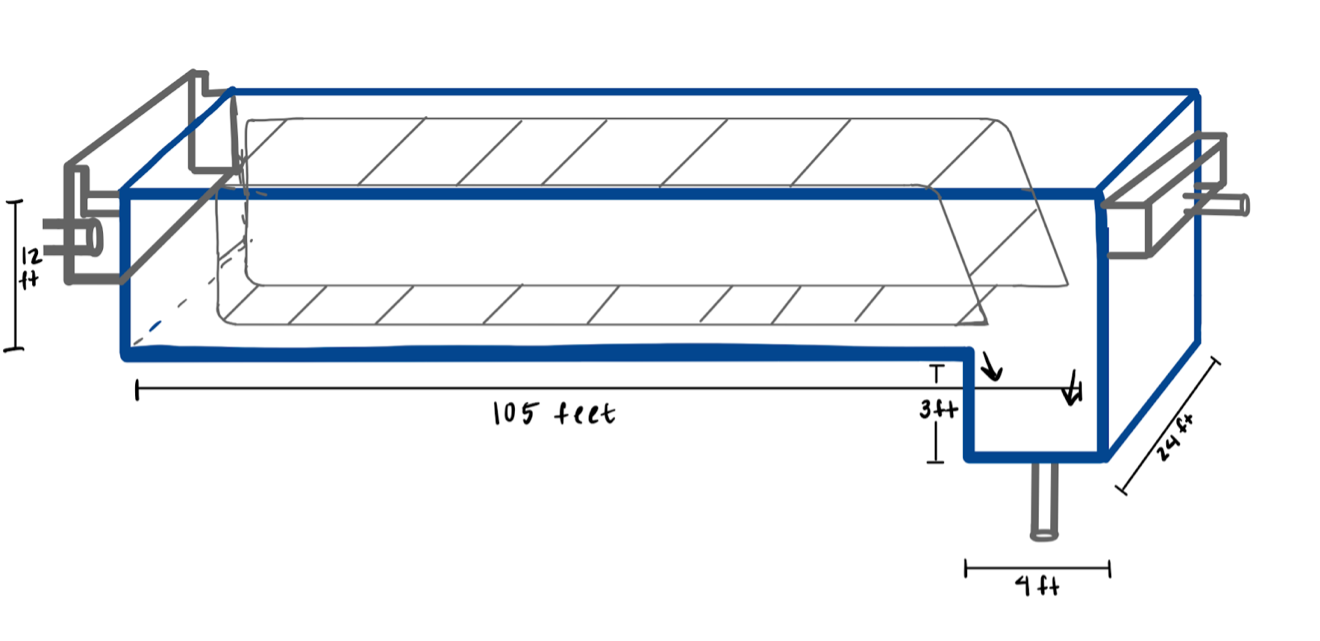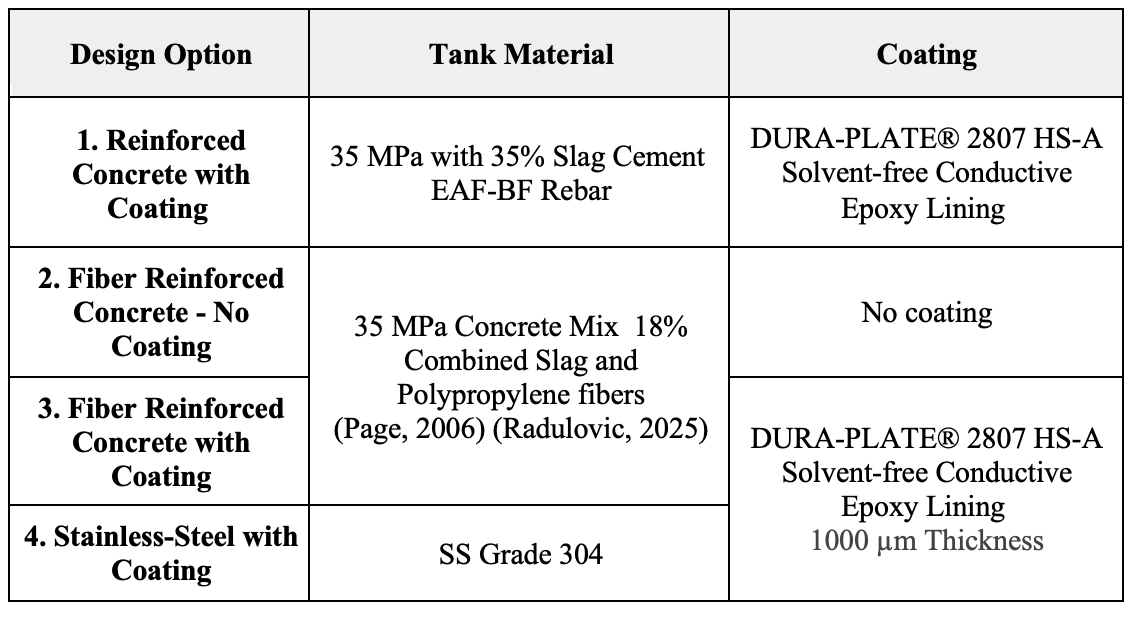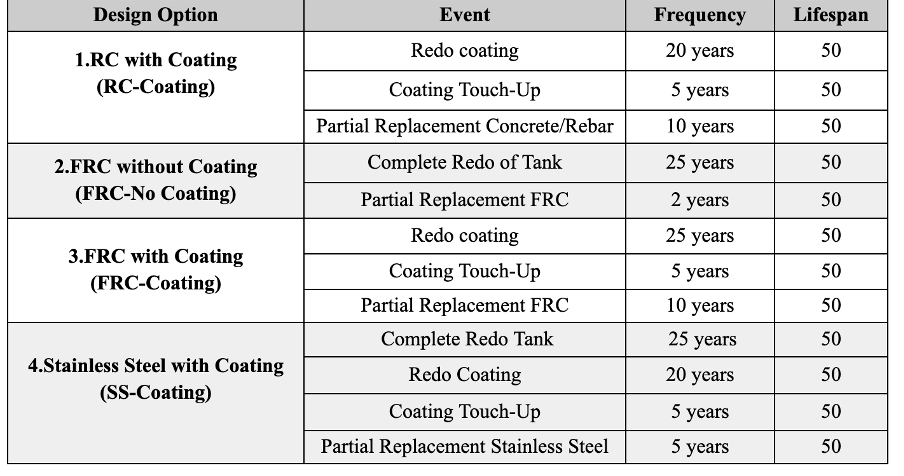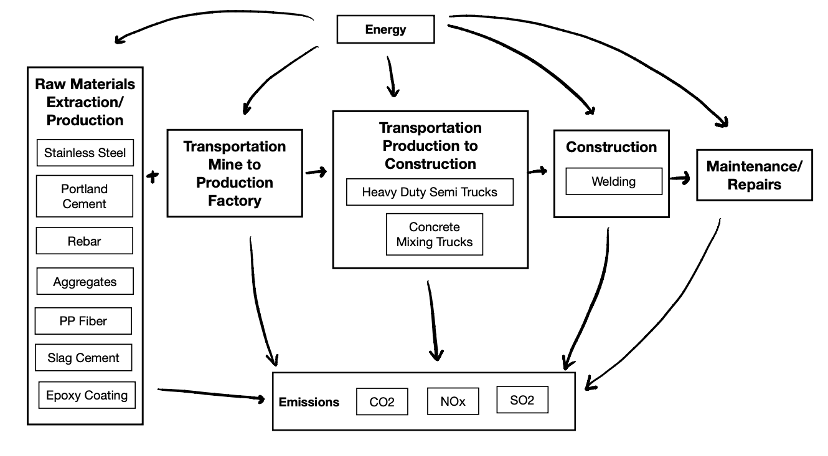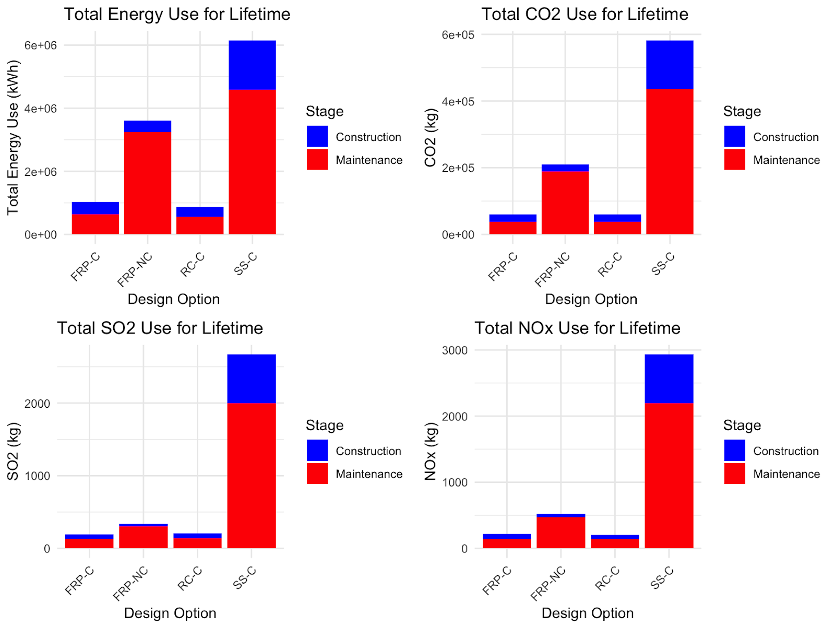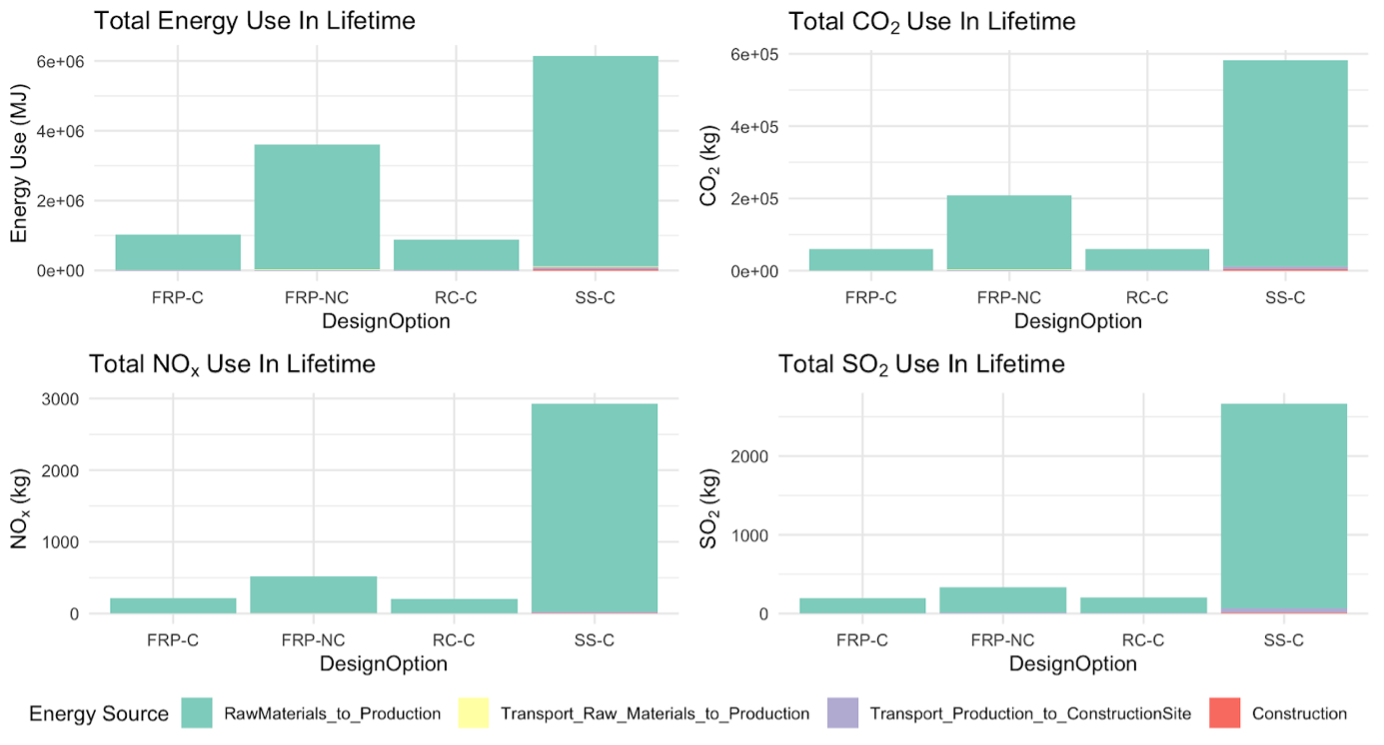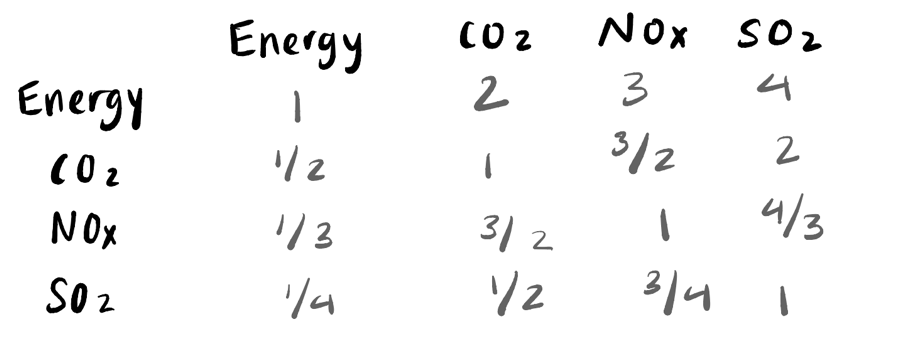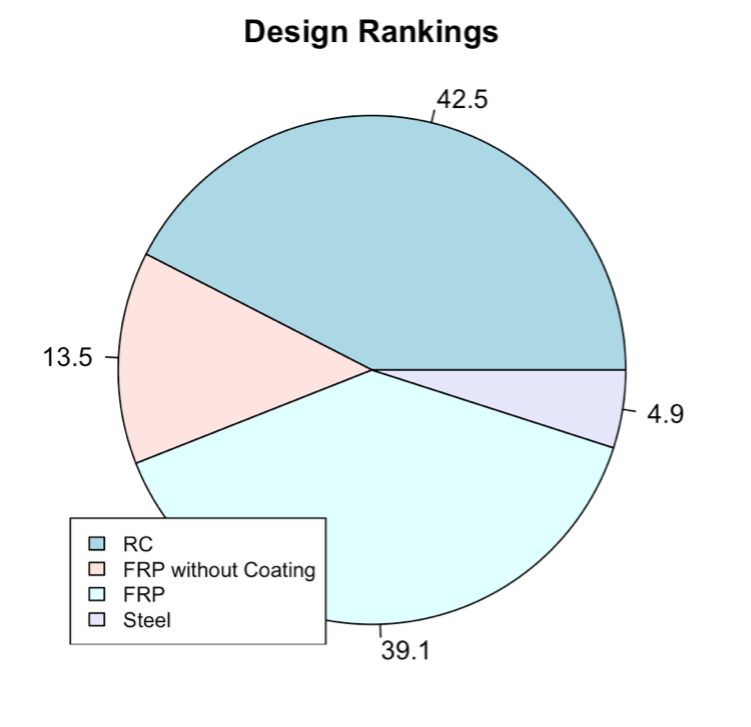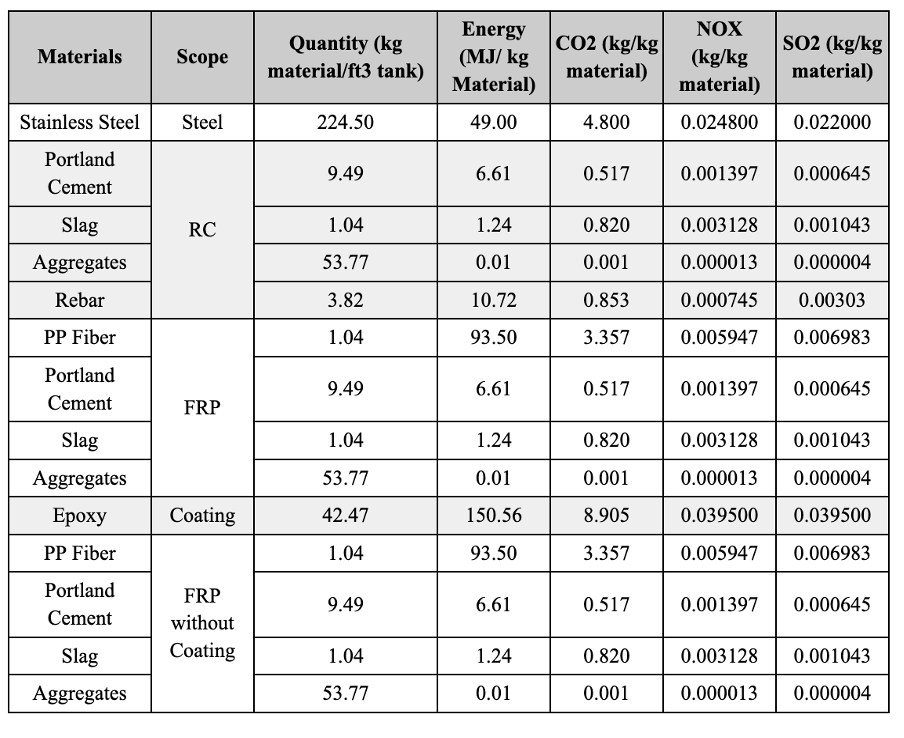Introduction:
Primary sedimentation tanks are essential to wastewater treatment. A primary rectangular sedimentation tank consists of subsystems: tank, weir, pipes, and scraper blades. The chosen subsystem was the tank.
Goal: The study’s goal was to compare four design options of a tank subsystem based on energy, CO2, NOX, SO2 indicators and use AHP analysis to find the best design alternative. Further analysis was done to find which material/boundary stage sustainability efforts should focus on.
Scope: The scope is the carbon footprint of the tank subsystem in the US where H2S corrosion is a major concern within the defined boundary.
1. Design Options: Design options included the most popular materials to build primary sedimentation tanks. Coating is virtually always used to protect sedimentation tanks, as corrosion can lead to structural failure. One design option excluded coating to test effects of higher repairs due to coating absence.
2. Lifecycle Timespan and Interventions:
Different Lifespans: All options were assumed to have a 50 years (ASCE, 2021) except for SS-Coating and FRC-No Coating, which were very prone to corrosion. These two had 25 year lifespans.
Tank Intervention: Each PR for RC-Coating and FRC-Coating options replaces 1/5 of the tank. PR for SS-Coating and FRC-No Coating replaces 30% and 35%, respectively.
Coating Interventions: The coating has a 20+ year lifespan (Sherman-Willaims, 2024). In 50 years, coating will be reapplied twice. Other repairs are assumed to total half a tank coating.
3. Life Cycle Cost Analysis
Raw Material Extraction/Production were included together since most studies found were cradle-to-gate. Transportation from mine to production was calculated assuming weight limit of heavy duty semi-trucks, their fuel efficiency, distance in the US, and % production waste. Quantities were material used during lifetime times 1.2 for production waste. Transportation from factory to construction site was assumed the same, but without production waste. Construction was considered.
3.1. General Bar Graph
The energy, CO2, NOX, and SO2 each design required during the tank’s lifetime were calculated (Fig 5). The best options were RC-Coating for energy/CO2/NOX and FRC-Coating for SO2. Most impact is because of maintenance, as maintenance was assumed to use at least one times the contraction material.
3.2. Engineering Perspective: Which boundary section had the highest impact?
Across all indicators and designs, Raw Materials/Production had a significantly higher impact than other boundary sections. Analyzing these results, companies should prioritize investing into better production processes before mining/construction/transportation. Efficient kilns and using sustainable fuels are recommended.
4. MCDA: With AHP
AHP weights were made using Dewalker and Shastri, 2022 and reasoning to transform these values from India to the US based partially on high air pollution in India (EPA). Referring to the scope, this means a RC-Coating tank subsystem is the best option for a rectangular primary sedimentation tank of average size in the US whose main problem is H2S corrosion. Analyzing if the AHP made sense, all consistency ratios were significantly below 0.10, so this AHP was acceptable (Saaty, 1987) (Demir, 2024).
References:
- ASCE’s 2021 Infrastructure Report Card Wastewater. ASCE’s 2021 Infrastructure Report
Card . (2023, July 7).
https://infrastructurereportcard.org/wp-content/uploads/2020/12/Wastewater-2021.pdf
- Demir, A., Dinçer, A. E., Çiftçi, C., Gülçimen, S., Uzal, N., & Yılmaz, K. (2024). Wind farm site selection using GIS-based multicriteria analysis with Life cycle assessment integration. Earth Science Informatics, 17, 1591–1608. https://doi.org/10.1007/s12145-024-01227-4
- Dewalkar, S. V., & Shastri, S. S. (2022). Integrated life cycle assessment and life cycle cost assessment-based fuzzy multi-criteria decision-making approach for selection of appropriate wastewater treatment system. Journal of Water Process Engineering, 45, 102476. https://doi.org/10.1016/j.jwpe.2021.102476
- Environmental Protection Agency. (n.d.). Gasoline sulfur. Retrieved January 4, 2025, from https://www.epa.gov/gasoline-standards/gasoline-sulfur
- Gomes, F., Brière, R., Feraille, A., Habert, G., Lasvaux, S., and Tessier, C. (2013). “Adaptation of environmental data to national and sectorial context: Application for reinforcing steel sold on the French market.” Int. J. Life Cycle Assess., 18(5), 926–938.
- Josa, A., Aguado, A., Heino, A., Byars, E., & Cardim, A. (2004). Comparative analysis of available life cycle inventories of cement in the EU. Cement and Concrete Research, 34(8), 1313–1320. https://doi.org/10.1016/j.cemconres.2003.12.020
- Kočí, V., & Loubal, T. (2012). LCA of liquid epoxy resin produced based on propylene and on glycerine. Acta Environmentalica Universitatis Comenianae (Bratislava), 20(Suppl. 1), 62–67. Retrieved December 30, 2024 https://fns.uniba.sk/fileadmin/prif/actaenvi/ActaEnvi_2012_Suppl.1/10_S_Koci_Loubal_Acta2012_Suppl_1.pdf
- Marceau, M., Nisbet, M.A. and Van Geem, M.G., 2007. Life cycle inventory of portland cement concrete. Portland Cement Association.(http://www.nrmca.org/taskforce/item_2_talkingpoints/sustainability/sustainability/
sn3011%5B1%5D.pdf)
- Marinkovic, S., Radonjanin, V., Malesev, M., & Lukic, I. (2008). Life cycle environmental impact assessment of concrete. In Advances in Environmental Research, Volume II (pp.195–228). Nova Science Publishers. Retrieved December 30, 2024, from https://www.diva-portal.org/smash/get/diva2:994722/FULLTEXT01.pdf#page=195
– Norgate, T. E., Jahanshahi, S., & Rankin, W. J. (2004). Alternative routes to stainless steel – A life cycle approach. In Proceedings of the 10th International Ferroalloys Congress (INFACON X) (pp. 815–823). Retrieved December 30, 2024, from https://www.pyro.co.za/InfaconX/010.pdf
- Özdemir, A., Günkaya, Z., Özkan, A., Ersen, O., Bilgiç, M., & Banar, M. (2018). Lifecycle assessment of steel rebar production with induction melting furnace: Case study in Turkey. Journal of Hazardous, Toxic, and Radioactive Waste, 22(2), 04018010. https://doi.org/10.1061/(ASCE)HZ.2153-5515.0000385
- Page, K. M. (2006). Repairs to the primary tanks at a wastewater treatment plant. Concrete Repair Bulletin, 15(5), 15–19. Retrieved from https://www.icri.org/wp-content/uploads/2024/04/CRBSeptOct06_Page.pdf. Accessed December 30, 2024.
- Saaty, T. L. (1987). The scaling of priorities for multiple criteria decision making. Mathematical Modeling, 9(3-5), 9 https://www.researchgate.net/publication/362349026_The_Analytic_Hierarchy_Process.
- Sherwin-Williams Protective & Marine. (2023.). Dura-Plate 2807 HS A: Product data sheet. Sherwin-Williams. Retrieved December 15, 2024, from https://protectiveeu.sherwin-williams.com/product_documentation/product-data-sheets/english-pds/pds-dura-plate-2807-hs-a-issue-1.pdf
- Sherwin-Williams Protective & Marine. (2024). Tank linings: Product brochure. Sherwin-Williams. Retrieved December 5, 2025, from https://industrial.sherwin-williams.com/content/dam/pcg/sherwin-williams/protective-marine/emeai/gb/en-gb/pdfs/brochures/Tank-Linings-Product-Brochure-Sherwin-Williams-English.pdf
- Yin, S., Tuladhar, R., Sheehan, M., Combe, M., & Collister, T. (2016). A life cycle assessment of recycled polypropylene fibre in concrete footpaths. Journal of Cleaner Production, 112(Part 4), 2231–2242. https://doi.org/10.1016/j.jclepro.2015.09.073
Steel Liquid Storage Tank | Water Distribution Network | Dam | Primary Sedimentation Tank/Wastewater Treatment
